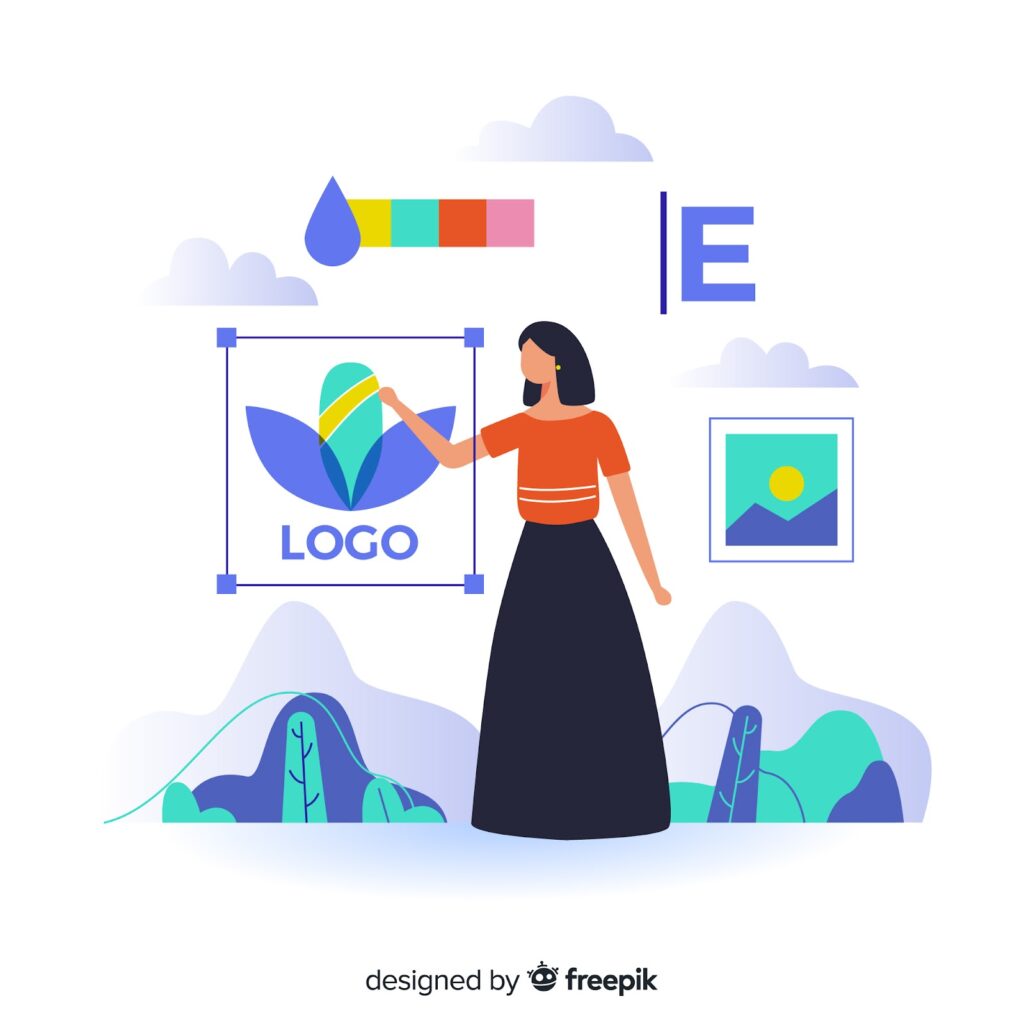Instagram isn’t just a place for visual storytelling—it’s a platform where brand identity is built one scroll at a time. Your logo is one of the first things people see, and on Instagram, where every second counts, clarity wins.
In this article, you’ll learn why simple logos consistently outperform complex ones, how to design with mobile and Instagram in mind, and how your logo can support your broader brand presence—especially as you grow your audience or business.
The Power of Minimalism on Mobile
On Instagram, your logo shows up in places that are small and fast-moving: your profile photo, Story Highlights, the corner of a reel, or in a product tag. People are not zooming in—they’re glancing. If your logo is crowded with details, thin fonts, or multiple colors, it won’t be legible. A simple logo cuts through all of that.
It doesn’t need to tell your whole story. It just needs to be clear, consistent, and easy to recognize at a glance.
This is especially important for students, creators, or early-stage brands starting to build online credibility. Many of them are learning just how much visuals influence audience growth. A great example is outlined in this post on Students Growing on Instagram, which explores how students benefit from visual clarity, strong messaging, and smart branding choices—starting with the logo.
How Simple Logos Help with Brand Growth
A simple logo scales well, whether it’s appearing in a reel, sitting atop your bio, or being used as a watermark. It’s easier to remember and becomes a core part of your brand’s recognition across social channels.
Design-wise, minimal logos also adapt better when you expand your brand from Instagram to other platforms. They sit better on marketing assets, website headers, or even printed merch.
Creators and small business owners are recognizing that visual clarity supports audience trust. As Instagram becomes increasingly competitive, the connection between branding and growth has become more obvious—especially with tools like TikTok and Instagram Reels working together. This is explored in depth in this guide on growth, which outlines how streamlined visuals help brands build awareness faster across platforms.
Designing Your Logo for Instagram Success
If your logo was designed for print, or even for desktop web, it might not perform well on Instagram. In mobile view, detailed symbols, cursive fonts, or taglines get lost. A smart move is to create a simplified version of your logo just for social use—often called a secondary or icon logo.
You don’t need to hire a design agency to start. If you’re looking for an easy way to experiment with ideas, a free or low-cost tool like this logo creator can help you try bold fonts, icons, and layouts until you land on something that feels right. From there, you can refine or work with a designer to finalize your branding.
The goal isn’t just to look nice—it’s to be seen and remembered.
Keep Your Content and Logo in Sync
Your logo doesn’t exist in a vacuum. It’s part of your larger visual identity—and it should feel like it belongs with your Instagram content. That includes your post designs, Reels, Highlights, and even your captions. If your logo is minimal and clean, but your feed is chaotic, the overall brand impact becomes confusing.
That’s why many successful creators build a small visual guide: brand colors, font styles, grid layout rules, and tone. The more unified your visuals feel, the more trustworthy and professional your profile becomes.
A strong logo can act as the entry point to deeper brand relationships. And as highlighted in this discussion on Social Media and Businesses, a consistent brand identity—including visuals—makes it easier for followers to feel connected and supported, especially when they’re deciding who to trust online.
Why Simplicity Doesn’t Mean Boring
Minimal doesn’t mean lifeless. In fact, some of the world’s most iconic brands—Nike, Apple, Headspace—use logos that are just one shape or word. But those visuals carry meaning because they’re clear, repeated, and emotionally consistent.
If you’re building a personal or business brand on Instagram, simplicity gives you room to grow. As you evolve, your logo remains flexible and effective across different types of content—without needing to be redesigned every year.
Well-designed logos don’t need to explain everything. They just need to be remembered.
The Psychology Behind Minimal Logo Success

Beyond clarity and visibility, simple logos also tap into how people process visual information. Our brains are wired to recognize and recall basic shapes, consistent patterns, and minimal elements faster than complex ones.
Why simplicity wins in human behavior:
- Faster recognition: People recognize simple shapes in less than a second
- Better memory recall: Viewers remember clean icons more easily
- Emotional response: Clean design feels modern, calm, and intentional
- Association building: The fewer distractions in a logo, the more room for emotional connection
Tools like Hootsuite make it easier to schedule Instagram content, stay consistent with branding, and track how your logo and visuals perform across posts and Stories.
Branding for Multi-Use Scenarios
Instagram isn’t a one-size-fits-all platform. Your logo may appear in Reels, Highlights, carousels, profile views, and even branded merchandise or YouTube thumbnails if you expand. That’s why creating a logo that works across various uses is smart—not just stylistically, but practically.
A flexible logo should:
- Fit in a circle (for profile photos)
- Look good on both light and dark backgrounds
- Work as a watermark (in corners of videos or carousels)
- Be recognizable even without text
This is especially helpful if you’re planning to use Instagram as a hub while growing across platforms or marketing channels. The ability to “plug and play” your logo into different content types saves time and ensures consistent brand recognition.
Test Before You Commit
Before finalizing a logo—especially if you’re creating or reworking one for Instagram—test it. Not just on your design screen, but in real-life formats. See how it behaves in an actual Instagram profile photo, reel cover, or Highlight button.
Use these quick tests:
- Upload it as your profile image and preview on mobile
- Add it as a corner icon in a carousel post to test visibility
- Place it next to your content colors to check contrast
- Zoom out to 50% on your screen—can you still recognize it?
According to Later’s Instagram profile picture tips, your logo is one of the most important visual cues for new visitors. If it’s hard to recognize or too detailed, you could be losing potential followers before they even explore your content.
Evolving Your Logo as Your Brand Grows
You don’t need to get your logo perfect right away. Many successful brands start with a basic design and refine it over time as their content style, audience, and confidence grow. The key is to start with something that works at a basic level and then upgrade it as your vision becomes clearer.
Think of your logo as something that grows with you. You can start with a minimalist monogram or simple icon and then add versions with subtle animation, color variations, or taglines for different uses.
Brands that try to do everything at once—design, message, style, content, growth—often end up with visuals that feel overloaded. Starting simple keeps things focused and helps your audience connect without confusion.
The Hidden Bonus: Time and Mental Energy
Simple logos don’t just look better on Instagram—they also make your life easier. You’ll spend less time fixing issues, reformatting files, or wondering if your logo looks blurry in a reel. You’ll also spend less mental energy on whether things look “good enough.”
That clarity gives you more room to focus on what really matters: creating content that helps, inspires, or informs your followers. Whether you’re sharing a tip, starting a conversation, or showing your process, a clean logo frees your visuals from distraction and makes your message more direct.
If your logo adds confusion, you’ll always be tweaking. If it adds clarity, you’ll get to focus on connection. And that’s where Instagram growth really begins.
Final Thoughts
In the fast-moving world of Instagram, attention is earned quickly—and lost even faster. A clean, minimal logo helps your audience recognize you immediately and associate your content with professionalism and purpose.
Whether you’re a creator, student, or small brand, a simple logo isn’t a shortcut—it’s a smart strategy. It works across formats, adapts with your growth, and supports your broader brand identity in subtle but powerful ways.
If you’re ready to refresh your Instagram presence, start with your logo. Strip it down to its core idea, test it at small sizes, and pair it with visuals that match your voice. Simplicity might just be your strongest move.





